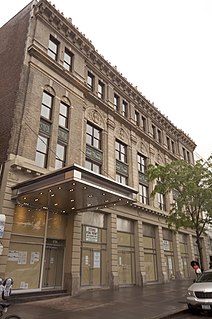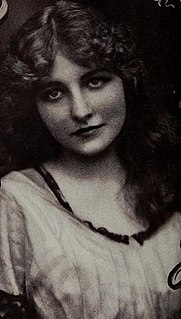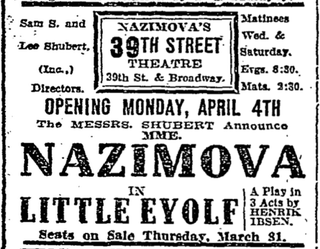
Fine Feathers is a 1912 drama in four acts by Eugene Walter.

Fine Feathers is a 1912 drama in four acts by Eugene Walter.
The play started as a scenario by Walter Hackett called "C.O.D.". Hackett, behind by $3,000 on his board bill at the Hotel Algonquin, negotiated with Frank M. Case, then manager of the Algonquin (he would later buy the hotel in 1932), to settle his account in exchange for twenty-five percent of all royalties on "C.O.D.". Hackett had learned his lesson, when 4 years earlier he landed in jail after trying to pay his hotel bill at the Castleton in Staten Island with forged checks. [1] Eugene Walter was then called to whip the play into shape for production. [2]
First produced for the stage as Fads and Frills by Charles Dillingham in 1910, it was abandoned as a failure after a three-week run. [3] Sam Shubert and Lee Shubert thereafter produced the play as Homeward Bound. It premiered in New York on January 28, 1911 at the Daly's Theatre [4] and subsequently went on tour, but was losing money and further performances were suspended. On March 27, 1911 the New York Daily Tribune announced that the Shuberts were preparing to make another production of Homeward Bound, this time starring Margaret Illington. [5] The New York Clipper wrote that Walter had changed the title of his play again, to Who's to Blame?. [6] Whether it was true or a subtle April Fool's joke (it was published April 1), the new title for the third rewrite of the play was Mrs. Maxwell's Mistake. It was anticipated to premiere April 17, 1911 at the Maxine Elliott Theatre [7] [8] but was rescheduled at the last minute for the following week; it ended up premiering at the Park Theatre in Bridgeport CT for one show on April 20. [9] It finally made its Broadway debut on April 24 at the Maxine Elliott Theatre, but was again a commercial failure.
After three unsuccessful attempts as a comedy, Eugene Walter decided sometime after May 1911 to rewrite the play as a drama.
Theatrical agent and producer Harry Frazee met Walter on a train ride from Chicago to New York City, and convinced him that his latest rewrite of the play, now titled Fine Feathers, was the best thing he had ever written. He offered the playwright a contract and a royalty check in exchange for significant creative control. [10]
His confidence boosted by Frazee's enthusiasm and money, Walter felt that he might finally have a box office hit on his hands and decided to approach Frank M. Case, who was still entitled to twenty-five percent of all royalties, and on June 4, 1912 an agreement was signed by which Case sold all his rights in the play to Walter for $200. [11]
The play opened at the Cort Theatre in Chicago August 12, 1912. [12]
Bob Reynolds, earning $25 a week, occupies a bungalow on Staten Island which he is trying hard to own. His wife has had five years of domestic drudgery, as she calls it when John Brand, Bob's old classmate, but now a rich and unscrupulous man of affairs, proposes to put $40,000 into the young man's purse provided he will certified to the use of an inferior grade cement in the building of a large water dam.
Bob lightly rejects the proposition but Mrs. Reynolds enters into a secret understanding with Brand to use her influence with her husband to earn the $40,000 after plainly telling Bob that he is a fool for scorning such an offer. When Bob still adheres to his resolution, he is anon confronted by the issue either of losing his ambitious wife or subscribing to Brand's terms, and he yields.
Five years later the Reynolds are living in a fashionable house on Long Island, but Bob is paying the wages of his sin. He has speculated, lost and must make good a check of $10,000 against an overdrawn account. In a frenzy of liquor he accuses Brand of having ruined him and demands more money on penalty of dragging him to jail. Brand taunts him with the threat that Mrs. Reynolds will also be drawn into the vortex of ruin, if he persists in exposing things, but on second thought protects Bobs check. The desperate condition of things has finally opened to the wife's mind to the consequences of the dishonesty to which she has sacrificed her husband, and now, willing to begin life all over, they are rejoicing in the news that the threatened arrest has been averted, when the information comes that the dam built of the defective cement has been swept away and the lives of a whole community have been destroyed. This hastens the climax.
In a graphic scene, the remorse stricken husband prepares his wife for what is to come. He takes the telephone and rings up the police station directing that an officer be sent to his house address. The electric lights are extinguished in a flash, the sharp report of a pistol rings out and the wife sinks into the divan with a heart rending moan. [13]
H.H. Frazee's Production
The play's convoluted origin and subsequent success made it prime ground for litigation.
There have been several adaptations of Fine Feathers.
Nine Feathers was a one-act burlesque with a cast of 5, written by Fred Donaghey and created as a curtain raiser for "The Girl at the Gate". It was tried out in Detroit and was a big hit according to reports. [20]
In February 1913, an announcement was made to the media by H.H. Frazee's press office that negotiations had been concluded between himself and Hans Bartsch & Co. representing Ruggero Leoncavallo, who would write an opera score to Fine Feathers. The project never occurred and may have been a publicity stunt. [21]
Fine Feathers was novelized twice.

Harry Herbert Frazee was an American theatrical agent, producer and director, and owner of the Major League Baseball Boston Red Sox from 1916 to 1923. He is well known for selling Babe Ruth to the New York Yankees, which started the Curse of the Bambino.

Albert Edward Anson was a British stage and screen actor. Born in London, he made his first appearance onstage in 1895. He left the stage briefly to pursue a degree in engineering and returned to appear with Beerbohm Tree's company in 1904. He gained fame as a Shakespearian actor appearing on London and New York stages.

The Shubert Theatre is a Broadway theater at 225 West 44th Street in the Theater District of Midtown Manhattan in New York City. Opened in 1913, the theater was designed by Henry Beaumont Herts in the Italian Renaissance style and was built for the Shubert brothers. Lee and J. J. Shubert had named the theater in memory of their brother Sam S. Shubert, who died in an accident several years before the theater's opening. It has 1,502 seats across three levels and is operated by The Shubert Organization. The facade and parts of the interior are New York City landmarks.

The Longacre Theatre is a Broadway theater at 220 West 48th Street in the Theater District of Midtown Manhattan in New York City, United States. Opened in 1913, it was designed by Henry B. Herts and was named for Longacre Square, now known as Times Square. The Longacre has 1,077 seats and is operated by The Shubert Organization. Both the facade and the auditorium's interior are New York City designated landmarks.

The Booth Theatre is a Broadway theater at 222 West 45th Street in the Theater District of Midtown Manhattan in New York City. Opened in 1913, the theater was designed by Henry Beaumont Herts in the Italian Renaissance style and was built for the Shubert brothers. The venue was originally operated by Winthrop Ames, who named it for 19th-century American actor Edwin Booth. It has 800 seats across two levels and is operated by The Shubert Organization. The facade and parts of the interior are New York City landmarks.

George Dunton Widener was an American businessman who died in the sinking of the RMS Titanic.

Laura Nelson Hall was an actress in theater and vaudeville stock companies in the late 19th century and early 20th century.

Four New York City theaters have borne the name Wallack's Theatre. Each has had other names before or after, or both. All are demolished.

What's Cookin'? is a 1942 American musical film directed by Edward F. Cline and starring The Andrews Sisters, Jane Frazee, Robert Paige and Gloria Jean. The film is based on the story Wake Up and Dream written by Edgar Allan Woolf.

Look Homeward, Angel is a 1957 stage play by the playwright Ketti Frings. The play is based on Thomas Wolfe's 1929 largely autobiographical novel of the same title.

Oliver Morosco was an American theatrical producer, director, writer, film producer, and theater owner. He owned the Morosco Photoplay Company. He brought many of his theater actors to the screen. Frank A. Garbutt was in charge of the film business. The company was merged with Adolph Zukor's Famous Players-Lasky Corporation in 1916.

Eugene Walter was a playwright. He was the author of the hit play The Easiest Way.

Shubert Alley is a pedestrian alley in the Theater District of Midtown Manhattan in New York City. The alley, a privately owned public space, connects 44th and 45th Streets and covers about 6,400 square feet (590 m2). It runs through the middle of a city block, parallel to Eighth Avenue to the west and Broadway to the east. The western half of the alley abuts the Shubert and Booth theaters, while the eastern half is adjacent to One Astor Plaza. Because it is near several major theaters, the alley has been considered the geographical center of Broadway theatre.

The Second Time Around is a 1961 American CinemaScope Comedy Western film starring Debbie Reynolds as a widow who relocates her family from 1911 or 1912 New York to the Arizona Territory. It is based on the novel Star in the West by Richard Emery Roberts.

The Bronx Opera House is a former theater, part of the Subway Circuit, now converted into a boutique hotel in the Bronx, New York It was designed by George M. Keister and built in 1913 at 436 East 149th Street on the site of Frederick Schnaufer's stable. It was one of several theaters to come into the area that became known as the Hub. It was formally dedicated on opening night Saturday, August 30, 1913.

Max Figman, born in Vienna, Austria, and Lolita Robertson born in San Francisco, were a husband and wife acting duo who appeared on Broadway and in silent films together. Max was also a director and writer in his stage career. Max was 22 years Lolita's senior but the couple was long married and devoted to each other until Max's death in 1952. Max died on February 13, 1952, in a nursing home in Bayside, Queens, called Edgewater Rest, at the age of 85. They had two children, Max Jr. and Lolita Figman.

Within the Law is a play written by Bayard Veiller. It is the story of Mary Turner, a sales clerk who is wrongly accused of stealing and sent to prison. Upon her release, Turner sets up a gang that engages in shady activities that are just "within the law". After the police try to entrap her, she is mistakenly accused again, this time for murder, but she is vindicated when the real killer confesses.

Isabel Lamon, also billed as Isabel Baring, was an American actress in silent films. Among many roles, she played Meg March in the first filmed adaptation of Louisa May Alcott's Little Women.

The 39th Street Theatre was a playhouse in New York City located at the corner of 39th Street and Broadway. Originally called Nazimova's 39th Street Theatre after the actress Alla Nazimova, it was in operation from 1910 to 1925 when it was demolished to make way for an office building. Throughout its existence, it was owned by the Shubert family. Its architect was William Albert Swasey, who had designed or remodelled several other Broadway theatres for the family.

Fine Feathers is a 1921 American silent film directed by Fred Sittenham and starring Eugene Pallette, Claire Whitney, Thomas W. Ross, Warburton Gamble and June Elvidge, produced and distributed by Metro Pictures Corporation. The library of Congress shows a release date of June 20, 1921 but there is evidence that Fine Feathers was being screened on June 18 at the Rose Theater in Santa Rosa California and as early as June 17 at the Star Theater in Monterey California. This production is the second movie adaptation of Eugene Walter's 1912 play of the same name. Three complete 35 mm copies were donated by M.G.M. to the U.S. Archive. A nitrate picture negative, an acetate positive print and an acetate fine grain master, all kept at the Eastman Museum in Rochester, NY.
Fine Feathers+Eugene Walter+Frank M. Case.